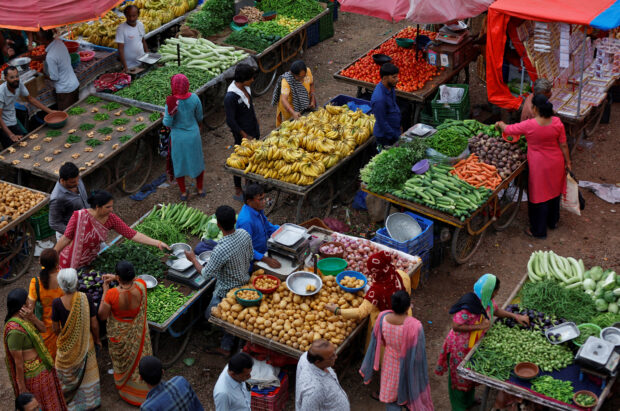India’s retail inflation hits three-month high in Nov on food prices

NEW DELHI -India’s retail inflation in November rose at its fastest pace in three months due to higher food prices, strengthening expectations that the central bank will not ease interest rates anytime soon.
Annual retail inflation rose to 5.55 percent in November from 4.87 percent the previous month. However, this was below that rate of 5.7 percent forecast by a Reuters poll of economists.
Food inflation, which accounts for nearly half of the overall consumer price basket, was 8.7 percent in November, up from 6.61 percent in October.
Core inflation, which strips out volatile food and energy prices, was estimated to be 4.05 percent-4.2 percent in November, compared with 4.2 percent-4.28 percent in October, according to four economists. The Indian government does not release core inflation figures.
“The uptick was entirely driven by the food and beverages segment, with all other groups either reporting a lower or an unchanged inflation print in November relative to October,” said Aditi Nayar of ICRA.
The latest print confirms the Reserve Bank of India’s (RBI) fears about volatile food prices pushing retail inflation higher. Last week, the bank, for the fifth consecutive meeting, kept the policy rates on hold as inflation remains above target and growth remains strong.
Article continues after this advertisementREAD: India keeps key rate unchanged on strong growth, inflation risks
Prices of cereals rose by 10.27 percent and vegetables by 17.7 percent in November over same month last year, while pulses were up by 20.23 percent, spices by 21.55 percent and fruit prices were up 10.95 percent in November over the same period last year.
In October, cereals rose 10.65 percent, vegetables prices rose 2.7 percent, pulses by 18.79 percent, spices by 22.76 percent and fruits by 9.34 percent.
November’s inflation rate was within the Reserve Bank of India’s (RBI) upper tolerance band of 2-6 percent for a third consecutive month but remained firmly above the 4 percent target.
Recently, RBI Governor Shaktikanta Das said the near-term outlook is “masked by risks to food inflation,” which might lead to an uptick in November and December even though core inflation, which excludes volatile food and fuel prices, has broadly moderated.
READ:Indian economy seen to exceed growth estimates after strong Q2 beat
India has taken a number of steps to cool price rises since July when inflation spiked over 7 percent. It has banned some exports of rice, wheat, sugar and onions. The government has said it will take more measures to contain food inflation.
India’s economic growth in the first half was an impressive 7.7 percent.
“Elevated food prices and solid economic growth suggest to us that the RBI will only start easing policy in the second half of 2024,” said Thamashi De Silva of Capital Economics.